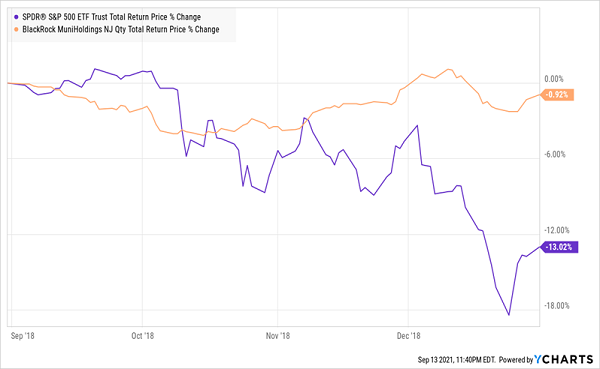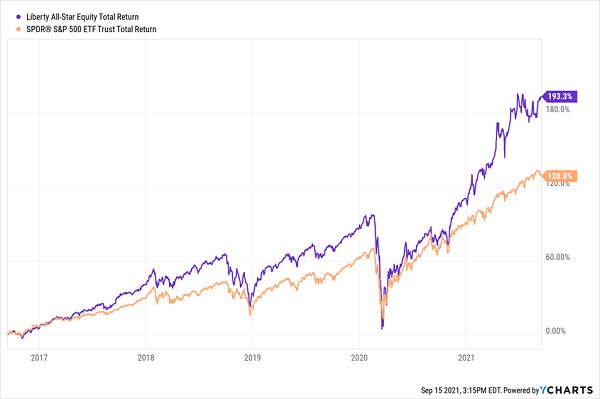Many folks see dividends as just a source of income. But they’re so much more! The two high-yield buys I’ll show you today, for example, are what I like to call “dividend Swiss Army knives.”
(One of these stealth funds pays an unheard-of 9.4% payout today, so you’d be pulling in a cool $9,400 in dividends for every $100K invested—enough to recoup your entire investment in dividends alone in a bit more than 10 years! It doesn’t get much safer than that.)
And yes, I know full well how corny “dividend Swiss Army knife” sounds. But the name works! Because apart from simply paying you a massive income stream, these two funds—closed-end funds (CEFs), to be specific—also:
- Fade your portfolio’s volatility (a key strength in the overbought market we’re facing today).
- Cut your tax bill. It’s true! One of the funds we’ll dive into pays a 4.8% dividend that’s tax-free—so it could be worth up to 7.5% to you, depending on your tax bracket.
- Build your nest egg fast, because their big dividends give you the option of reinvesting some (or all) of your payout, ballooning the value of your portfolio as you do.
Stock-Market Forecast Sees a Storm Ahead
I put “low volatility” at the top of the list above because many of the market indicators I watch are pointing to a choppy period ahead—so we income investors need to lock down our payouts now, then get set to pounce when the next selloff overshoots on some investments (as they always do!), giving us a clear shot at some “snap-back ready” gains.
Heck, even the mainstream media’s caught on to the selloff worry—and they’re usually the last to know. Case in point: CNN’s Fear & Greed Index, which has been green for months but just turned red.
Popular Market Alarm Goes Off

Fear/Greed Index Reading

Fear/Greed Index Reading
Source: CNN.com
This is a pretty simple indicator: over 50, the market is greedy. Less than that, it’s fearful. The indicator has stayed above 50, except for a couple recent dips into the 40s, but now it’s well below 40—and falling.
To be honest, there’s ample reason to be cautious about stocks these days, starting, of course, with the rocket ride the market’s been on since April 2020. We’re definitely due for a breather, and with September historically being the worst month of the year for stock-market performance, we could be in for one soon (we’ve already seen the pull back some 2% since the start of the month as of this writing).
Then there’s the delta variant, which threatens to hamper consumer spending, and worries about shoppers pulling back could trigger a selloff on their own, even if such a spending slowdown doesn’t ultimately appear.
So what do we do? Of course, we do not want to sell—we’d lose our dividends if we did that! Instead, we’ll look to the two CEFs below. They have key strengths that can see you through a crash, sustain your income as they do, and get you to the other side, where bargains will be waiting!
1. Instant Diversification and a Tax-Free Dividend
One thing you don’t want to do when the market is this pricey is to have 100% of your portfolio in stocks. At times like this, you’ll want to be sure you have exposure to assets like municipal bonds, or “munis,” which are issued by states, cities and other government organizations to pay for infrastructure projects.
A CEF like the Blackrock MuniHoldings NJ Quality Fund (NYSE:) is a good way to get that exposure.
MUJ boasts one of the biggest yields of any muni-bond CEF, at 4.8%, and its portfolio is rated more highly than those of comparable funds, too. MUJ also trades at a 1.7% discount to net asset value (NAV, or the value of the bonds in its portfolio), so you’re paying below market value here.
Here’s the real difference-maker: MUJ’s 4.8% dividend could be worth a lot more to you—as mentioned earlier, possibly up to 7.5%, depending on your tax bracket—as its payout is tax-free for most Americans.
That income stream is crucial, as I’ll explain in a bit, but what’s really important is that municipal bonds tend to be much less volatile than stocks. Take, for instance, the fear-driven selloff of late 2018. MUJ investors no doubt wondered what all the fuss was about!
MUJ’s Asset Protection Fully in Place

MUJ-Total Returns

MUJ-Total Returns
MUJ did pull back during the March 2020 crash (along with everything else), but it’s more than eclipsed its pre-crisis highs now, and “munis” are safer than they’ve ever been, because they rarely default (they boast an average five-year default rate of just 0.13% since 2010) and the Fed has stepped in to backstop the muni market throughout the pandemic.
In other words, the money you invest in MUJ has solid protection from the market’s broader losses—a very attractive feature today.
2. An All-American Fund Throwing Off a 9.4% Payout
Now let’s turn to stock-focused CEFs, where you’ll find plenty of options yielding 7% or more. Stock exposure is still key, of course, even though we do want to make sure we’re diversified, because no other asset class can match stocks for long-term returns. And buying through a CEF also gets you income to tide you over in a downturn (and, importantly, cash that you can use to reinvest during those unpredictable, fear-driven dips).
The Liberty All-Star Equity Fund (NYSE:) is a great tool for just this. It gives you exposure to blue chip stocks like PayPal (NASDAQ:), Amazon (NASDAQ:), Facebook (NASDAQ:), Adobe (NASDAQ:) and Google (NASDAQ:) but with a key difference: instead of the low (or no!) dividends these firms pay, USA throws off a massive 9.4% payout!
When you factor in that dividend, you see that USA investors have pocketed a total return that’s crushed that of the SPDR S&P 500 ETF Trust (NYSE:), most people’s go-to S&P 500 index fund, in the last five years.
USA Rides Its Dividend Past the Market

USA Total Returns

USA Total Returns
USA really is offering the best of all worlds for income investors: outperformance and big dividends we can use to pay our bills and/or reinvest when the market takes a short-term dip as fear overrides greed.
Disclosure: Brett Owens and Michael Foster are contrarian income investors who look for undervalued stocks/funds across the U.S. markets. Click here to learn how to profit from their strategies in the latest report, “7 Great Dividend Growth Stocks for a Secure Retirement.”

